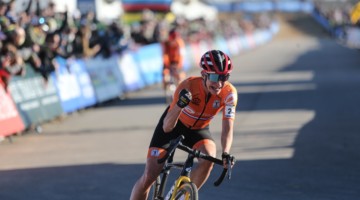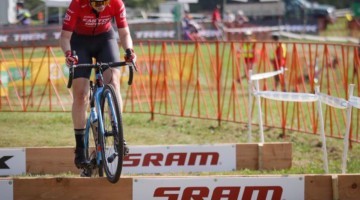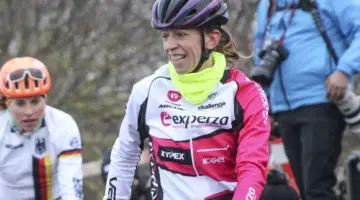This time around, when the phrase “the British are coming!” was shouted at nighttime in Massachusetts, the British could not be stopped by the Americans. The Brit in question? None other than Helen Wyman, cyclocross National Champion of Great Britain, who recently snagged not one, not two, but nine victories early season on American soil (and in the mud.) That’s right: she won every race that she started, from Nittany to Gloucester. Now back in Europe, she’s still dominating the races, taking a solo victory yesterday in Ruddervoorde. Our corespondent across the pond, Bart Hazen, sat down with Helen for a post-US debriefing.
by Bart Hazen
Cyclocross Magazine: You already won nine times in the United States in the early season. Did you expect to be that good already?
Helen Wyman: Hell yeah! Haha I knew the level of racing in America is good so it wasn’t going to be easy to win races, but I knew I would be in contention for every win before I arrived, so I was pretty relaxed about it all and really happy to have won every race.
CXM: Which race or races that you won in the USA are the most special to you? And why?
HW: All of them meant something. The best races were those at Charm City because of the whole experience there. The hardest fought were those at Gloucester, as the competition was really high there, and I won on courses that are not to my strengths, particularly Saturday’s race.
CXM: In which way does the American cyclocross scene differ from Europe, and to be specific, from Belgium?
HW: In America, the sport is participation-driven. They have over 1000 people racing during each day, the spectators that watch the races are pretty much locals and racers from the non-elite races. Belgium is more elite-driven and the spectators come specifically to watch their racer. It seems a much more friendly environment to outsiders, although this is helped by them speaking (almost) the same language.
CXM: In the old UCI ranking system, you would be the leader. Now it seems to be a rolling points system. Can you explain what it means? Or how the ranking works.
HW: Can any one explain how the UCI works?! From their publication on their website, it suggests it will be a rolling rotation; so every weekend you gain the points from that race and lose the points from the same weekend of the previous season. Plus, for the women we have C1 and C2 races this season, although the prize money is still the same for women’s C1 and C2 (unlike the men’s races, where the prize money is around 1200 euros for the win compared to 185 euros for women), but there is a points difference between C1 and C2.
CXM: Every UCI C1 cyclocross race has a women’s race this year. That’s a big development for the sport, I think. What’s your take on what Golazzo Sports is doing for the women?
HW: Does Golazzo have any C1 races? I know all the Superprestige series are C1s. Its great to have the races, but the UCI missed an amazing opportunity to give women equal opportunity to guys by making a different minimum prize list for the C1 races for women. You can provide every race in the world, but if there is no equality in important aspects like prize money or standard race times so the women’s race takes top billing by being immediately before the men’s, you aren’t developing the sport. Six of the nine races in America had equal prize money top three women and men. By providing the same opportunities, more women can race at the top level and can make the sport better through competition, plus sponsors are more interested, as the organizers use the women’s race for publicity too.
CXM: All right, besides World Championships in Koksijde, Belgium. Do you have other goals or specific races you want to win?
HW: As many as humanly possible! No, actually, the aim for the season is Worlds. It’s a big aim!
CXM: It seems both you and Ian Field are in better condition than one year ago. Did you change something in your training and/or build-up to the new season? Apart from the annual altitude camp in the Alps.
HW: No, not really. Every year you get a bit older and a bit stronger and can train a little bit harder, it’s just the way nature works. I think we have both have taken advantage of this and built on good seasons from last year to get even better.
CXM: What was it like to ride some road races with your cyclocross rival Hanka Kupfernagel on the Horizon Fitness-Prendas Ciclismo team? Who learned the most from whom?
HW: She is amazing, a really cool person and easy to race with. She was so calm even when she had a problem and was really inspiring to race with. I think I learned a lot from her. I think she probably learned that British people are constantly mocking each other but it’s just for fun and helps us all bond.
CXM: You are riding for the American Kona Factory team. Can you tell something about the bikes and equipment you are going to use this season?
HW: I’m riding purple and black carbon Kona Major Jake cyclocross bikes. They are equipped with Dura Ace, FSA finishing kit and TRP brakes. They are beautiful and I love them! I use Shimano wheels C24, C35 and C50s, all of which have Challenge tires on.
CXM: I have read somewhere you will do 35 races. Thus far you won 9 of them. So thats over 25% already. Where is this going to end?
HW: Around 35?!
CXM: What do you think about having two of the best female cyclocross riders Katie Compton and Marianne Vos riding for the same sponsor next year? Is that a good or bad thing, in your opinion, and why?
HW: They have such different styles of racing and women’s cyclocross specifically is such an individual sport, so I think it makes absolutely no difference who they race for. It’s a good thing for Rabobank as they have the World number one and the World champion together, so it’s great publicity. All publicity for women’s sport is a great thing.
CXM: Apart from the usual suspects (Vos, Compton, Van Paassen, Kupfernagel, Cant, Van den Brand, Nash), who will be a rider or riders to watch for this season?
HW: Well, I thought Pauline Ferrand Prevot would be one to watch this year but she seems to have trailed off this summer in mountain biking so may be a bit tired. Otherwise, I’d say the Swiss rider Jasmine Archerman could do some good things this year.
CXM: Last week there was a discussion/debate about a minimum wage for women cyclists. UCI president McQuaid stated that the sport isn’t at that level yet. Vos, Teutenberg and Bronzini took offense and supported the idea. What are your thoughts? Or, what needs to be changed to get this idea started.
HW: Well, I think both have good points of view. If you enforce a minimum wage for women’s pro teams, you will just reduce the amount of pro teams and mean club teams ride bigger races so it doesn’t solve anything. Equally, the racers need some kind of structure for wages to ensure it can be a good job.
I think the good pro teams have tried to set the example by paying good wages to their riders already but smaller teams just don’t follow suit. Maybe it’s time the UCI stepped up and promoted women’s racing a bit more themselves to help it gain more publicity and greater sponsorship, and in turn, better sponsorship opportunites and then finally, a minimum wage.
CXM: Are you optimistic about the growth and popularity of Women’s racing?
HW: Having been in America, I would say over there, definitely. They are so progressive in terms of equalizing men and women’s sport. Over here, it’s much more difficult to change the attitudes of people who run the sport when they are sometimes old school in their values.





























